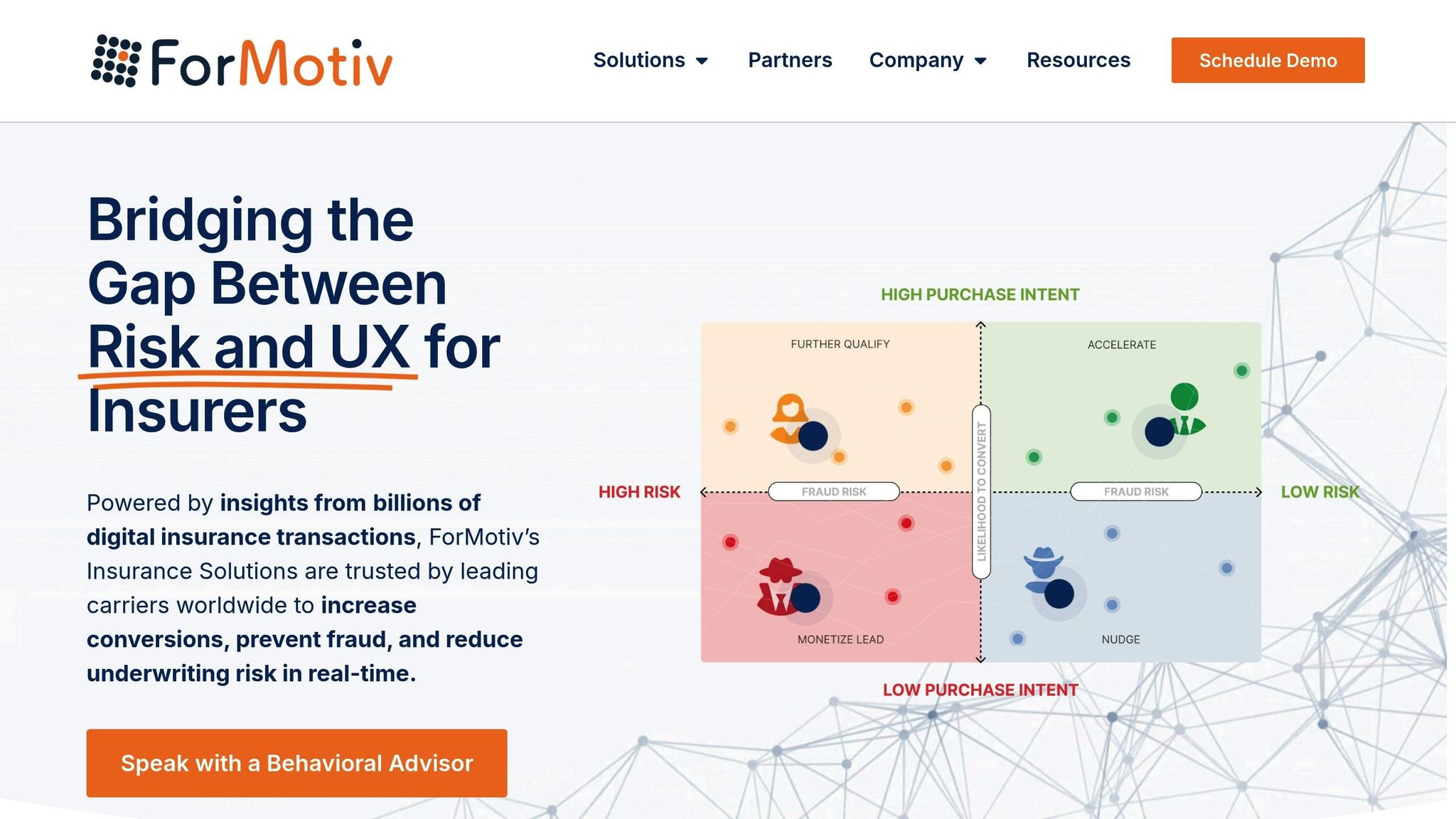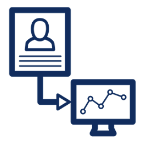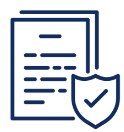The insurance industry in 2025 is being reshaped by advanced analytics tools. These tools help insurers tackle major challenges like fraud detection, underwriting accuracy, premium leakage, and agent performance monitoring. Key players like ForMotiv are leading the way with AI-driven behavioral analytics, offering real-time insights into applicant behavior to improve risk assessment, fraud prevention, and operational efficiency.
Key Highlights:
- Fraud Detection: Real-time analysis of behavioral patterns during applications reduces fraud, saving billions annually.
- Underwriting Improvements: Predictive models enhance risk evaluation, leading to better pricing and reduced premium leakage.
- Agent Monitoring: Tools track agent activity, ensuring compliance and improving productivity.
- Compliance: Platforms like ForMotiv integrate seamlessly with existing systems while adhering to privacy regulations.
The adoption of these tools is critical as fraud costs $308.6 billion annually, and premium leakage erodes profits by up to 10%. Insurers using advanced analytics report higher accuracy, faster processing, and significant cost savings. Embracing these solutions is no longer optional but essential for staying competitive in a rapidly evolving landscape.
Evident AI Insurance Roundtable 2025
ForMotiv: Behavioral Analytics for Insurance Professionals

ForMotiv is at the forefront of behavioral analytics, reshaping how U.S. insurers approach risk assessment, fraud detection, and operational efficiency. By combining a unique first-party behavioral dataset with real-time predictive analytics, ForMotiv helps insurers distinguish between genuine, risky, and fraudulent applicants. This innovation addresses a pressing issue: over the past eight years, application integrity for personal auto insurance has declined by more than 20% [2]. With over 1 billion auto insurance applications analyzed, ForMotiv’s solutions deliver dependable insights into behavioral patterns [7].
Real-Time Fraud Detection
ForMotiv’s fraud detection tools use behavioral analytics to pinpoint suspicious activity as it unfolds during the application process. By analyzing factors like hesitation, error rates, and cognitive load, the platform flags suspect applications instantly [1].
This real-time approach is essential, especially when insurance fraud costs the industry a staggering $80 billion annually, according to the Coalition Against Insurance Fraud [4]. ForMotiv has proven its effectiveness by helping carriers detect and stop various fraud attempts, ranging from simple form manipulation to complex forgery and premium evasion schemes. These insights not only prevent fraud but also support more accurate underwriting decisions.
Underwriting Risk Assessment
ForMotiv accelerates underwriting by identifying subtle behavioral risk indicators. For example, a Top 5 Property & Casualty (P&C) Carrier achieved a $10.2 million return on investment by using ForMotiv’s Lead Scoring Model. This model allowed the carrier to segment users based on their likelihood to buy, enabling personalized remarketing campaigns that boosted efficiency and drove measurable gains [2].
By enhancing underwriting precision, ForMotiv also helps insurers address costly issues like premium leakage.
Premium Leakage Prevention
Premium leakage – when insurers lose up to 10% of loss expenses – poses a significant financial challenge [8]. ForMotiv tackles this by identifying behaviors that suggest rate evasion, premium leakage, or eligibility misrepresentation during the application process [6].
The results speak for themselves: one P&C carrier saved $7 million in premium leakage by leveraging ForMotiv’s behavioral analytics [2]. By spotting risky behaviors in real time, the platform empowers insurers to correct issues like underpaid premiums and inaccurate risk assessments. This ensures carriers collect the full premium value tied to the actual risks they underwrite.
Agent Performance Monitoring
With agents responsible for 83% of P&C premiums and 90% of life insurance sales, monitoring their behavior is critical [9]. ForMotiv offers advanced tools to track agent activity, identifying patterns like input manipulation to lower premiums, data harvesting, or repetitive responses.
The platform provides a detailed audit trail, logging every input, device, and timestamp [10]. This eliminates uncertainty in disputes and ensures transparency throughout the application process. ForMotiv also enables carriers to group similar agent behaviors into actionable categories, allowing for targeted interventions. Additionally, it monitors onboarding success by evaluating new agents’ engagement levels, quote-to-bind ratios, and application completion rates, while flagging agents whose performance shows signs of decline [9].
Compliance and Integration Features
ForMotiv’s compliance and integration capabilities make it easy for insurers to adopt behavioral analytics without regulatory concerns. The platform complies with GDPR, CCPA, and PIPEDA data privacy standards, ensuring suitability across multiple jurisdictions [1]. Its “glass-box approach” uses curated first-party data that integrates seamlessly with existing datasets while maintaining privacy.
Implementation is straightforward, thanks to lightweight JavaScript integration [1]. ForMotiv supports both real-time data feeds and batch file processing, offering flexibility to fit various operational setups. This ensures insurers can incorporate behavioral insights into their workflows and decision-making processes efficiently.
"Partnering with FRISS is an exciting step forward for ForMotiv. The integration of our behavioural analytics technology with FRISS’s trust automation solutions will provide insurers with critical insights into applicant behaviour, helping them to mitigate risk and improve underwriting confidence." – Woody Klemmer, Head of Marketing at ForMotiv [5]
Key Features of Insurance Analytics Tools in 2025
Insurance analytics tools have come a long way, incorporating predictive modeling, AI, and real-time processing to address the pressing challenges faced by U.S. insurers. With fraud schemes growing more sophisticated and regulatory requirements becoming increasingly complex, these tools are now indispensable. Throughout this article, we’ll explore how solutions like those from ForMotiv are shaping the future of the industry.
Predictive Analytics for Risk Assessment
Predictive analytics is changing how insurers assess risks by diving deep into historical claims data, behavioral patterns, and external factors. This approach creates detailed risk profiles that go beyond the limitations of traditional underwriting.
One major insurer implemented predictive models and saw a 30% improvement in identifying fraudulent claims [11]. This advancement not only enhanced fraud detection but also reduced the occurrence of false positives, saving time and resources.
ForMotiv takes predictive analytics a step further by analyzing behavioral data during the application process. By examining hesitation patterns, error rates, and cognitive load indicators, the platform uncovers insights that traditional data sources often miss.
Healthcare fraud is a particularly tough nut to crack, costing the U.S. healthcare system an estimated $36.3 billion annually [13]. Predictive models help tackle this by assigning risk scores to providers. For instance, when a small outpatient clinic suddenly reported a 300% increase in chemotherapy drug billing – despite not employing an oncologist – the predictive system flagged the anomaly. This early detection prevented significant fraudulent payouts [13].
AI-Powered Real-Time Insights
AI has become a game-changer in the insurance world, offering real-time decision-making capabilities that give insurers a competitive edge. By detecting suspicious patterns, flagging inconsistencies, and identifying fraud networks, AI-powered systems are reshaping fraud prevention [12].
"In 2025, data is the most valuable currency in the insurance industry." [12]
These systems are constantly evolving, adapting to new fraud strategies by analyzing claim histories, provider behaviors, and patient interactions [13]. Natural Language Processing (NLP) is particularly effective at comparing clinical records with billing data to uncover overbilling or mismatched claims. For example, when a clinic submitted a claim for a full spinal MRI and orthopedic consult for a patient with mild back pain, NLP flagged the discrepancy, stopping the fraudulent payout before it occurred [13].
ForMotiv’s AI platform processes behavioral data in real time, identifying unusual input behaviors or data manipulation attempts. This enables insurers to act quickly and make informed decisions without delays.
The sheer scale of the fraud problem – costing American consumers at least $308.6 billion annually [13] – makes AI indispensable. Advanced tools, including large language models or real-time behavioral analytics help fraud teams work more efficiently by summarizing case histories and recommending next steps [13].
Regulatory Compliance and Reporting
With regulatory landscapes constantly shifting, compliance features are now essential for any insurance analytics tool. Modern platforms must automate the management of regulatory requirements while ensuring transparency in data usage and decision-making.
A recent study revealed that 78% of organizations plan to increase their tech budgets in 2025, with a significant portion aimed at compliance automation [14]. AI-powered tools are increasingly used to streamline regulatory reporting, identify compliance gaps, and ensure proper data handling [12].
Effective compliance management hinges on features like automated audit trails, role-based access controls, and secure data lineage mapping. ForMotiv addresses these needs by using curated first-party data that integrates smoothly with existing datasets, all while adhering to strict privacy standards. This ensures insurers can trust the integrity of their decision-making processes.
Real-world examples highlight the impact of automation in compliance. Porto, a Brazilian banking and insurance firm serving 13 million customers, used intelligent automation to tag PII data, update data asset ownership, and document data assets. This approach improved governance efficiency by 40% [15].
"We have preset rules that look for patterns in the names and descriptions of the fields, and if those patterns are matched, we classify that as a potential PII field. This has saved us tons of hours." – Danrlei Alves, Senior Data Governance Analyst at Porto [15]
Integration is another critical factor. By 2025, 85% of insurers are expected to operate at least one core system entirely in the cloud [16]. Analytics tools must integrate seamlessly with cloud-based systems while maintaining high security and compliance standards. ForMotiv’s lightweight JavaScript integration makes implementation effortless, supporting both real-time data feeds and batch processing without disrupting existing workflows. This ensures insurers can meet compliance demands while staying agile in a rapidly evolving industry.
sbb-itb-ec84a5c
Practical Applications and Measurable Results
Leveraging advanced detection and compliance tools, the practical use of these technologies is transforming the insurance landscape in the U.S., delivering clear, measurable benefits. From preventing billions in fraudulent claims to streamlining underwriting processes, these tools are reshaping operations across the industry.
Fraud Prevention and Claims Accuracy
Insurance fraud is a massive financial burden, costing the U.S. over $308.6 billion each year [18]. For the average American family, this translates to an additional $400 to $700 in annual premiums [17]. Life insurance alone contributes to $74.7 billion in fraud-related losses annually [17].
ForMotiv tackles this issue by analyzing behavioral patterns during the digital application process. Its behavioral analytics flag "red flag" behaviors that traditional fraud detection methods often miss. For instance, if an applicant hesitates on specific questions, makes unusual corrections, or displays other suspicious patterns, ForMotiv identifies these in real time.
The implications go beyond initial fraud detection. Research from RGA and MIB highlights that fraud, misrepresentation, nondisclosure, and anti-selection lead to industry losses of about $75 billion annually [3]. ForMotiv’s Non-Disclosure Solution addresses this by identifying patterns of nondisclosure early in the application process. This proactive approach helps insurers reduce mortality slippage, particularly in accelerated underwriting scenarios.
By focusing on fraud prevention and claims accuracy, insurers can streamline operations and improve agent performance, setting the stage for more efficient workflows.
Streamlined Underwriting Processes
Underwriters today face mounting pressure to balance speed with accuracy. ForMotiv’s behavioral analytics offer underwriters a detailed view of applicant behavior, enabling them to apply appropriate scrutiny without delaying genuine customers.
With predictive models achieving 92% accuracy in identifying risk patterns [21], insurers can prioritize applications more effectively. By analyzing digital behaviors across various insurance types – life, auto, commercial, property, pet, and jewelry – ForMotiv provides real-time insights into purchase intent and risk profiles.
A standout example involves a Top 10 Life Insurance carrier. ForMotiv’s analysis revealed that 72% of applications had two or more questions corrected by agents after initial submission [20]. This insight allowed the insurer to identify issues in the application process and refine training and compliance strategies.
Nondisclosure also poses a significant challenge. Approximately 7% of life policies include some form of nondisclosure, and nearly 17% of life insurance claims involve nondisclosure, costing insurers over $12 billion annually [20]. By shifting from reactive claim investigations to proactive risk assessment, ForMotiv helps insurers reduce these losses and improve overall efficiency.
Better Agent and Customer Experiences
Agents play a crucial role in the insurance industry, driving 83% of property and casualty premiums and 90% of life insurance sales [9]. ForMotiv’s Agent solution provides real-time insights into agent behavior, helping insurers understand performance variations and implement targeted interventions.
The platform allows insurers to group agents by behavior and performance, enabling more precise benchmarking and targeted improvements. By tracking these metrics across agent populations, insurers can identify areas needing additional training or support.
ForMotiv also identifies friction points in the digital application process that can slow down agents or cause confusion. Addressing these pain points not only speeds up policy writing but also reduces risk exposure and enhances customer satisfaction.
Premium leakage – an issue costing insurers nearly $40 billion annually [20] – is another area where behavioral analytics prove valuable. By identifying discrepancies between applicant responses and actual risk profiles, ForMotiv helps prevent underpricing, ensuring more accurate premium calculations over time.
Feature Comparison: ForMotiv and Insurance Analytics Tools
When choosing insurance analytics solutions, it’s essential to understand how ForMotiv’s behavioral analytics set it apart from traditional tools. This comparison builds on ForMotiv’s real-time, behavior-driven approach and its unique ability to analyze digital body language.
Unlike traditional tools that primarily focus on demographics, ForMotiv captures over 5,000 behavioral data points during every application process [19]. This level of detail supports more precise underwriting decisions and faster fraud detection by uncovering applicant intent beyond surface-level data.
"Is your applicant high-intent because they bought a car this morning, or because they got in an accident this morning?"
– ForMotiv [1]
This question underscores ForMotiv’s strength in distinguishing between different types of intent. While traditional systems might label both scenarios as "high-intent", ForMotiv’s behavioral analytics can pinpoint genuine interest versus potential risks.
ForMotiv analyzes digital body language – including typing speed, hesitation, error rates, and corrections – in real-time [1]. This instant feedback allows carriers to adjust the user experience as it happens, unlike traditional platforms that rely on batch processing or delayed reports.
The results speak for themselves: ForMotiv’s models boast 92% accuracy in identifying risk patterns [21]. By analyzing millions of past applications, it connects specific behaviors to outcomes like misrepresentation, nondisclosure, and fraud [20].
Comparison Table
Here’s a closer look at how ForMotiv stacks up against traditional insurance analytics tools:
| Feature | ForMotiv | Traditional Insurance Analytics Tools |
|---|---|---|
| Data Collection | 5,000+ behavioral data points per application [19] | Demographics and claims history [22] |
| Analysis Method | Digital body language and behavioral patterns [1] | Group-level characteristics and historical trends [22] |
| Processing Speed | Real-time behavioral analysis [20] | Batch processing or delayed insights [22] |
| Intent Detection | Holistic view of applicant intent [1] | Limited intent analysis capabilities [22] |
| Data Type | Granular, curated 1st-party behavioral data [19] | 3rd-party data and readily available information [22] |
| Predictive Accuracy | 92% accuracy in risk pattern identification [21] | Variable accuracy depending on data quality |
| Distribution Channels | Direct and agent channels [1] | Typically channel-specific solutions |
| Behavioral Insights | Hesitation, error rates, cognitive load analysis [19] | Limited behavioral understanding |
| Fraud Detection | Real-time behavioral fraud indicators [23] | Post-application or claims-based detection |
| Application Scope | Life, auto, commercial, property, pet, jewelry [1] | Often specialized by insurance type |
ForMotiv’s versatility extends across departments, including marketing, underwriting, fraud detection, data science, digital experience, and agent distribution teams [1]. Traditional tools, on the other hand, often require separate solutions for each department, creating data silos and integration headaches.
ForMotiv also shines in agent analytics, delivering insights that traditional tools miss. A Top 10 Life Insurance carrier shared:
"You helped us find the agents who represent themselves better than their employer and customer."
– Top 10 Life Insurance carrier [20]
While traditional behavioral biometrics compare users to their own baseline behaviors, ForMotiv benchmarks new users against millions of past outcomes [20]. This population-level comparison provides a broader context that individual baselines can’t achieve.
Conclusion
By 2025, U.S. insurers are projected to face staggering losses – $40 billion annually due to fraud and over $12 billion from life insurance nondisclosure cases. These challenges are expected to push premiums up by $400 to $700 for American families, all stemming from fraud-related expenses[20].
ForMotiv is stepping in to address these issues head-on. By utilizing detailed behavioral data at every stage of the application process, the company has delivered impressive results, such as a $10.2 million return on investment for a top 5 P&C carrier and $7 million in premium leakage savings for another[2]. Their real-time behavioral analysis is a game-changer, providing actionable insights in just two days – far outpacing traditional methods that can take over two weeks to process claims[24].
The numbers speak volumes. Carriers that integrate ForMotiv’s solutions achieve an 89.4% risk prediction accuracy, compared to just 67.3% with traditional methods[24]. They’ve also slashed processing costs from $245 per assessment to $27 and boosted customer satisfaction scores from 65.4 to 83.2[24].
Shifting from reactive to proactive operations is no longer optional – it’s essential. ForMotiv’s behavioral intelligence tools help insurers tackle rising fraud rates, meet regulatory demands, and exceed customer expectations. This comprehensive approach not only improves underwriting efficiency and fraud detection but also enhances agent performance monitoring, positioning carriers to thrive in a rapidly changing landscape.
As the industry faces mounting challenges, adopting advanced analytics quickly is critical to staying competitive and safeguarding profitability.
FAQs
How does ForMotiv use behavioral analytics to detect fraud in the insurance industry?
ForMotiv uses behavioral analytics to uncover subtle patterns in the way users interact, helping insurers spot potential fraud like ghost broking, bot activity, and nondisclosure. By tapping into real-time behavioral data, ForMotiv delivers insights that help insurers improve risk assessment and reduce premium leakage.
This forward-thinking strategy not only bolsters fraud detection but also streamlines operations. It empowers insurance professionals to make smarter, data-backed decisions while safeguarding their business from financial threats.
What are the main advantages of using real-time behavioral data for underwriting and preventing premium leakage?
Leveraging real-time behavioral data is transforming how insurers approach underwriting and tackle premium leakage. By analyzing this live data, insurers can spot patterns and anomalies that traditional methods might miss, significantly boosting the accuracy of risk assessments and improving fraud detection.
This approach also speeds up decision-making by providing a clear, up-to-the-minute view of customer behavior and potential risks. The benefits? Insurers can streamline operations, cut losses, fine-tune pricing strategies, and offer policyholders a more tailored and responsive experience.
How does ForMotiv protect sensitive data and ensure compliance with privacy regulations when integrating with existing systems?
ForMotiv places a strong emphasis on safeguarding data privacy and adhering to regulatory standards. To achieve this, it uses robust security measures like data anonymization, encryption, and strict access controls. These steps ensure that sensitive information stays secure while complying with privacy regulations such as GDPR and CCPA.
On top of that, ForMotiv’s analytics tools are built to integrate effortlessly with your current systems, all while keeping data security intact. By sticking to industry best practices and prioritizing compliance, ForMotiv helps businesses reduce risks and maintain customer trust.





